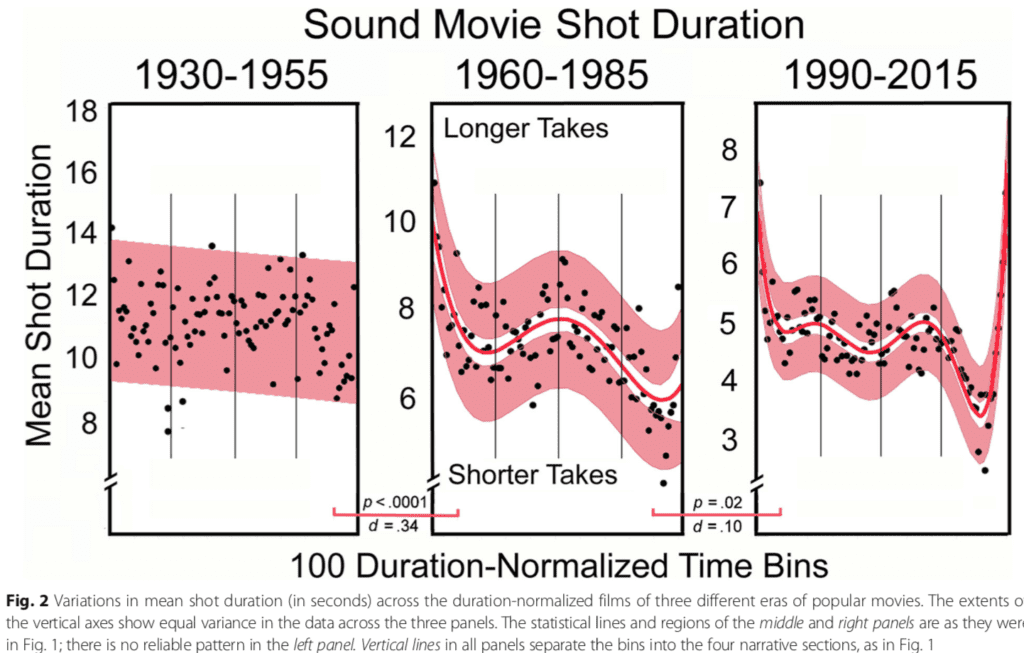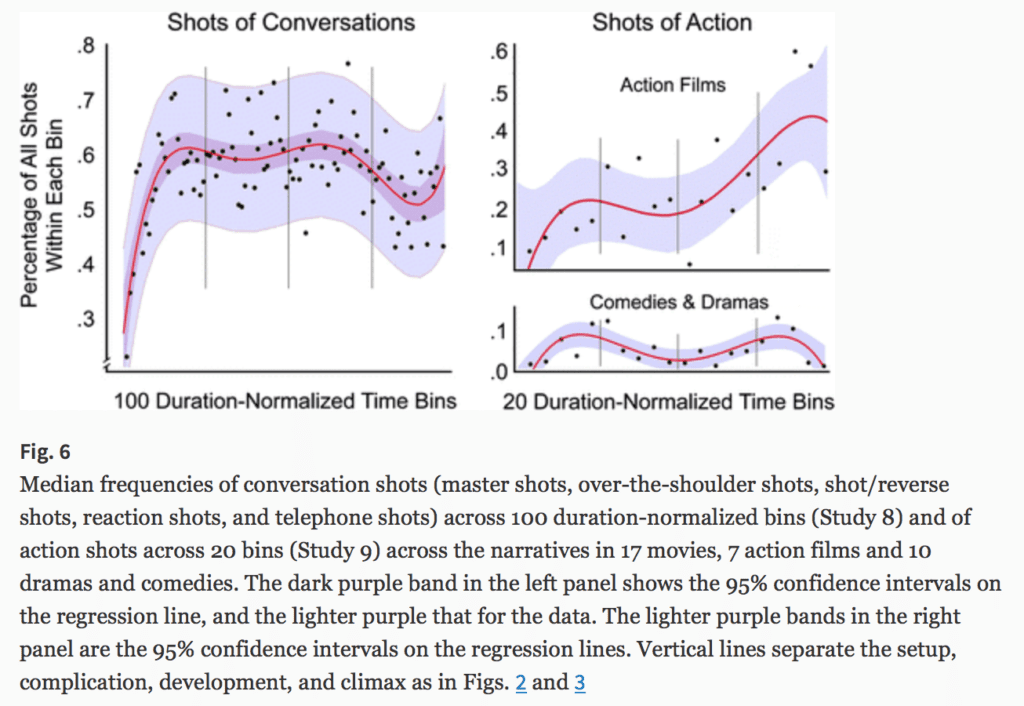James Cutting writes:
Movies have changed dramatically over the last 100 years. Several of these changes in popular English-language filmmaking practice are reflected in patterns of film style as distributed over the length of movies. In particular, arrangements of shot durations, motion, and luminance have altered and come to reflect aspects of the narrative form. Narrative form, on the other hand, appears to have been relatively unchanged over that time and is often characterized as having four more or less equal duration parts, sometimes called acts – setup, complication, development, and climax. The altered patterns in film style found here affect a movie’s pace: increasing shot durations and decreasing motion in the setup, darkening across the complication and development followed by brightening across the climax, decreasing shot durations and increasing motion during the first part of the climax followed by increasing shot durations and decreasing motion at the end of the climax. . . .

I’m fascinated by the topic, and I love the idea of people studying storytelling in a systematic way.
People might also be interested in this other paper by Cutting, Narrative theory and the dynamics of popular movies:
Using a corpus analysis I explore a physical narratology of popular movies—narrational structure and how it impacts us—to promote a theory of popular movie form. I show that movies can be divided into 4 acts—setup, complication, development, and climax—with two optional subunits of prolog and epilog, and a few turning points and plot points. . . . In general, movie narratives have roughly the same structure as narratives in any other domain—plays, novels, manga, folktales, even oral histories—but with particular runtime constraints, cadences, and constructions that are unique to the medium.
Here’s one of the patterns he found:

P.S. Excellent surname for someone who studies the construction of films.
You may enjoy this too then! https://pudding.cool/2017/08/screen-direction/
Although even by today’s standards, Sergei Eisenstein would likely be among the fastest in terms of shot duration. Early Soviet cinema was wildly different from American cinema in this way.
https://en.m.wikipedia.org/wiki/Soviet_montage_theory
I don’t know why anyone would think film techniques could have developed faster. TV didn’t exist in any meaningful amount until the 1950’s and its techniques were a few technical generations behind film, closer to the 1930’s era in the immobility of cameras and the need to locate microphones on (typically over) small sets that had to be highly lit for a medium that was not only grey scale but which was mostly flat. It wasn’t until videotape became common in the 1980’s that TV techniques jumped ahead, and that was mostly by imitating the hand-held effects of amateurs. I remember the first few times I saw Hill Street Blues: the moving camera looked and felt childish but it was different and the technique, which was quickly over-used, conveyed the amateur’s sense of immediacy. It was only then that cameras really became smaller and more mobile; film makers wanted more control over the level of amateurishness and immediacy so they developed smaller cameras and smaller steady cam rigs. Sound lagged; you needed 2 or 3 people to manage boom mics. (Jerry Lewis experimented with locating lots of small mics on sets, etc.) Directional mics have improved a lot but the sound requires processing to spread it out across the visual field.
Jump cut techniques really took off when commercials started to be filmed on video. A major reason: just really cheap to shoot a lot and you didn’t have to wait for processing so you could actually stand around a monitor and try out different ideas and then cut stuff together. Because you could duplicate tape more easily, you could try a lot cheaper. An issue with CGI films for years was that shots were encouraged by rendering limits to be shorter, but that’s an entire subject of its own.
But my actual point was the rhythm of film matches the rhythm of the audience’s expectations and plays with those. If you’re ever seen NFL Redzone, it appears we’re approaching 0 attention span, except narratively we’re now in an era in which plots may move glacially. So one aspect of the current situation is that technology is shortening time while narrative increases time. Not long ago, the technology to switch instantly from game to game to game was slower and required spoken seque to prepare the audience for a shift that might not happen smoothly AND because the expectation was the audience wanted to be informed about what was happening AND because the networks were invested in how they made the productions and they saw those as ‘shows’ with traditional forms of continuity. That broke down as the technology improved so now they dump you from game to game without warning so you don’t even realize who is playing.
But at the same time, you have shows which might take 5 episodes before anything happens at all. That relies on something else: the release of all episodes at once so the audience knows from social media that something will in fact happen. That stretches the concept of narrative and thus of how a show works.
I wanted to add: expect AR to affect movie shot length. As you capture depth of field, you can create an actual moving perspective. This means the camera can shift from behind one actor to behind another. I can imagine a long shot where the camera traverses ground between groups of actors who move around without a single cut. Call it continuous perspective. Another thing, I’d say much cooler, is the idea of individual story lines: since the shot is just data, you can make multiple scenes and thus multiple perspectives through a movie. I’m not talking about filming video game alternatives: you could see a story from each protagonist’s perspective and then mix perspectives. You could even do that algorithmically so people could design their own.
Palko here. Doing this from my phone so I’m having trouble signing in.
Lots of stuff here I will try to come back to later, but one quick point I want to make. Though this is less of a factor for big-budget Productions, the labor costs of editing have gone down by at least a couple of orders of magnitude in the past 20 years.
There’s actually a whole field in cinema studies that deal with statistical aspects of narrative etc in film called cinemetrics. Interesting field, but really hard to satisfy both film theorists and statisticians.
You can find more info here:
http://www.cinemetrics.lv/index.php
It would be interesting to see how the pacing correlates with story emotional arc.
Kurt Vonnegut claimed that all stories fall into one of eight kinds:
1. Man in a Hole
2. Boy meets Girl
3. From Bad to Worse
4. Which Way is Up?
5. Creation Story
6. Old Testament
7. New Testament
8. Cinderella
http://www.openculture.com/2014/02/kurt-vonnegut-masters-thesis-rejected-by-u-chicago.html
Modern computation has vindicated Vonnegut and reduced this to six kinds of stories:
1. Rags to Riches (rise)
2. Riches to Rags or Tragedy (fall)
3. Man in a Hole (fall then rise)
4. Icarus (rise then fall)
5. Cinderella (rise then fall then rise)
6. Oedipus (fall then rise then fall)
The emotional arcs of stories are dominated by six basic shapes. Andrew J. Reagan, Lewis Mitchell, Dilan Kiley, Christopher M. Danforth, Peter Sheridan Dodds
https://arxiv.org/abs/1606.07772
Use of a story arc is also relevant to teaching and presentations which can help one avoid being boring, but also risks seeing relevance where there is none. For further entertainment, someone has similarly characterized physics seminars into nine kinds:
https://manyworldstheory.com/2013/10/03/the-9-kinds-of-physics-seminar/